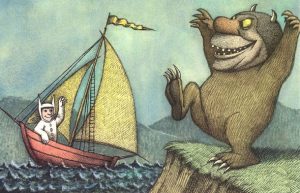 Maurice Sendak is best known for his Caldecott Medal winning illustrated children’s book, Where the Wild Things Are (1963), made into a film by Spike Jonze. Given the importance of childhood experience and how it is remembered to the Wide Image, Ulmer often included in the Hypermedia course a book of short essays by authors of children’s books on the art and craft of writing for children: Worlds of Childhood, edited by William Zinsser. (1998). Sendak’s essay, “Visitors from My Boyhood,” is organized as a mystory, addressing each of the popcycle slots in order to explain the source of his poetics, which suggests there is something intuitive or inherent in the popcycle as a matrix of imagination. Two other features recommending Sendak’s craft as relay for an Exercise is that his stories were rarely more than 300 words (the length of one micro fiction, the narrative building-block of mystory documentation), and the drawings did not merely illustrate the words but developed the diegesis of the world in their own terms. Students used Sendak’s essay as a relay: making an inventory of his popcycle; extracting a template of examples for each slot; finding equivalents in their own experience.
Maurice Sendak is best known for his Caldecott Medal winning illustrated children’s book, Where the Wild Things Are (1963), made into a film by Spike Jonze. Given the importance of childhood experience and how it is remembered to the Wide Image, Ulmer often included in the Hypermedia course a book of short essays by authors of children’s books on the art and craft of writing for children: Worlds of Childhood, edited by William Zinsser. (1998). Sendak’s essay, “Visitors from My Boyhood,” is organized as a mystory, addressing each of the popcycle slots in order to explain the source of his poetics, which suggests there is something intuitive or inherent in the popcycle as a matrix of imagination. Two other features recommending Sendak’s craft as relay for an Exercise is that his stories were rarely more than 300 words (the length of one micro fiction, the narrative building-block of mystory documentation), and the drawings did not merely illustrate the words but developed the diegesis of the world in their own terms. Students used Sendak’s essay as a relay: making an inventory of his popcycle; extracting a template of examples for each slot; finding equivalents in their own experience.
 –Family (Personal): Composition of mystory usually begins with a memory from early childhood, life with the family. Up to three such memories are allowed, to avoid getting stuck deciding on one that is most important (that dilemma if it arises is resolved when the remaining slots are filled, following the rule what resembles assembles). Sendak proposed two memories: the first was one of his earliest, an encounter with one of the pedagogical objects Pasolini mentioned, a book his older sister received from her book club. The book was very thick with a hardcover of pale green with gold lettering. Although not yet able to read, Sendak was fascinated with the book and demanded to have it, creating so much commotion the parents made his sister give it to him. When he finally returned it to his sister it was in bad shape, including suffering from being licked all over.
–Family (Personal): Composition of mystory usually begins with a memory from early childhood, life with the family. Up to three such memories are allowed, to avoid getting stuck deciding on one that is most important (that dilemma if it arises is resolved when the remaining slots are filled, following the rule what resembles assembles). Sendak proposed two memories: the first was one of his earliest, an encounter with one of the pedagogical objects Pasolini mentioned, a book his older sister received from her book club. The book was very thick with a hardcover of pale green with gold lettering. Although not yet able to read, Sendak was fascinated with the book and demanded to have it, creating so much commotion the parents made his sister give it to him. When he finally returned it to his sister it was in bad shape, including suffering from being licked all over.
–Entertainment (Mythology): The popcycle premise is that identity is configured through identifications with people, places, and things during formative years: just as one has a capacity (potentiality) for language in general, with one’s native language depending on the chance of birth; similarly one has a capacity for imagination, and one’s native imagination (wide image) is formed within uniquely particular circumstances (visceral learning). A shortcut to determine which identifications took is just introspection: what remains in memory? Writer’s are good relay resources modeling these shaping identifications of which they necessarily become aware in learning their craft. For Sendak the memory was of The Wizard of Oz, and one scene in particular that he said “stole into my life in 1939 and has been flooding my work continually ever since.”
I was eleven when I saw the movie, and I remember it vividly because of how intensely in frightened me. The moment I am talking about is the one when Dorothy is trapped by the Wicked Witch of the West, and the witch takes an hourglass and turns it over and says something horrible like, “When the sand runs out, you’re dead, honey.” Judy Garland is left alone in the room, and one of her best moments ever was her way of saying, “I’m frightened,” and then, as though that realization has just actually dawned on her, says it a second time, “I’m frightened.” I still remember how her hand went to her head–the way she had of fluttering her hand, her desperation was so convincing. There was no way out of that room, nothing she could do. And suddenly, in the witch’s crystal ball, she sees her Auntie Em, back in Kansas, standing in the yard and calling to her. And she rushes to the crystal ball, and stands over it and screams, “Auntie Em! Here I am!”
–Community (History). Family and Entertainment memories are personal and convincing because they “belong to me.” The assumption of the History slot in the popcycle is that identity is formed within a social habitus, which is a major source of education (interpellation) received uncritically and internalized. To access this level of distracted education students first must decide with which Community they identify. Not everyone grows up in a home town. Community could also be an ethnic group, religion, race, military branch, nation. Whichever Community chosen, the story told must be one the Community tells about itself (what the Community remembers). Many students actually knew very little about their communities, so that some research was required. A shortcut was just to recall street names, festivals, memorials, school names and the like, to make a short-list. At that point some personal connection may help the selection. Sendak’s relay is somewhat awry, in that he did have a strong emotional association with his History event (as did James Joyce with the history of Parnell). The particular contribution of the History story is register a Value important to the Community. The Event documented by Sendak was the story of the Lindbergh baby.
The major event of my childhood was the kidnapping of the Lindbergh baby in 1932. That nightmare was probably the origin of my conviction that children can’t be shielded from frightening truths. Although I was only three, I remember intensely the details of the Lindbergh case. Lindbergh was our Prince Charles, and his wife was our Princess Di. I particularly remember a newspaper that had the front-page headline LINDBERGH BABY FOUND DEAD and a photograph of a scene in the woods with a black arrow pointing to something awful. I’ve since learned that Colonel Lindbergh threatened to sue if the New York Daily News didn’t have the morning edition pulled off the newsstands, so I guess not many people saw the picture. But I saw the picture.
The first phase of composition is to document each of these scenes (in your own popcycle): use micro fiction form, three micros (900 words) for each register, focusing on the diegesis of the event. The goal is to capture and annotate details of the scene, since wide images emerge in patterns of repeating signifiers.

If Sendak were looking for a pattern to unify his stories, the green color would be significant. The green Witch obviously resonates with the book cover. The green of a mouldering corpse would be only in imagination.